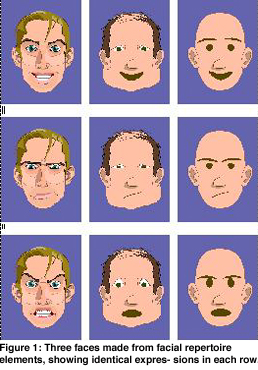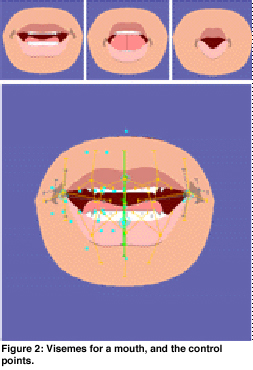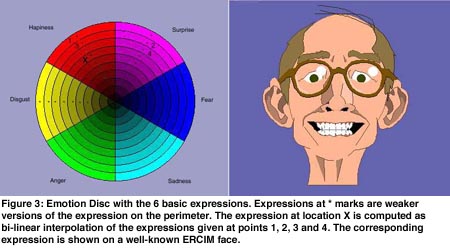
ERCIM News No.44 - January 2001 [contents]

![]()
ERCIM News No.44 - January 2001 [contents]
by Zsófia Ruttkay
The CharToon system is a tool dedicated to design and animate 21/2D non-photorealistic, cartoon faces for web and other applications. Novel features are based on the concept of a facial repertoire, containing ready-to use, but adaptable facial features as well as facial expressions. With constraint-based animation editing facilities, the user can define expressions on a high level and design the dynamism and behaviour of a face. CharToon was developed at CWI in a 3-year project and will be sold in 2001 by EPICTOID, a CWI spinoff company.
Humanoids with expressive faces have become popular in social user interfaces as well as virtual reality, telecommuni-cation, Web and entertainment applications. There is demand for tools with which a non-professional user can make a variety of expressive and appealing faces with little effort and resources. CharToon is a vector-graphics based facial animation tool written in Java, with which one can construct faces which can be animated and compose animations for faces. A player module can generate the animation on the fly, real-time, based on scripted description of the face and the animation. The basic CharToon system was already introduced earlier in ERCIM News No. 35.
In the last year, CharToon has been extended with facilities enabling the re-use of higher-level building blocks, both when making faces and when animating them. CharToon is equipped with two ready-to-use, extensible and adaptable sets of repertoires:
Due to consistent labeling of the so-called control points which define deformations, the facial and the expression repertoire are orthogonal: an expression can be ëappliedí for any face made of (adapted) facial feature repertoire elements (see Figure 1).
A specific set of facial expressions are the visemes, containing mouth shapes for talking heads (see Figure 2). By using different viseme repertoires, the lipsync for different languages or for different user groups (eg hearing impaired) can be automated.
Another extension to CharToon is the Emotion Disc: a device which allows to generate and explore a continuum of facial expressions, assuming that initially the snapshots of the 6 basic expressions - joy, surprise, fear, sadness, anger and disgust - were designed. The further elements of the emotion space are generated by blending (animation parameters of) two of the given emotions in a certain way. The design of Emotion Disc is based on an almost 50-year old (though debated) observation by Schlosberg, stating that the six basic emotional expressions are perceptually related in such a way that they can be arranged in a two-dimensional space along a circle. The continuous space of Emotion Disc is, accordingly, a round disc showing a neutral face in the centre and maximal expressions on the perimeter (see Figure 3). The Emotion Disc can be used in all stages of the animatorsí work. It has also been used as a direct controller of the expression of an avatarís face.



Currently we are implementing a new version of CharToon, extended with constraint-handling mechanisms. The constraints are to be used in two roles:
By using constraints as conceptual means to declare expressions, we will be able to address the still open issues of superimposing and concatenating pieces of animations and experiment with different strategies.
Though CharToon was initially developed as a research tool, it raised much interest in a broad circle of potential users. To turn it into a commercial product, the spinoff company EPICTOID was created recently, starting to sell CharToon in 2001.
Links:
http://www.cwi.nl/CharToon
Please contact:
Zsófia Ruttkay - CWI
Tel: +31 20 592 4144
E-mail: Zsofia.Ruttkay@cwi.nl
Paul ten Hagen - EPICTOID
E-mail: Paul.ten.Hagen@cwi.nl